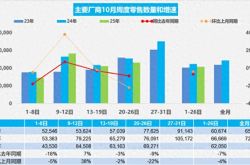From Gaming to Computing Power Titan: Can NVIDIA's Market Cap Eclipse US$5 Trillion?
![]() 10/10 2025
10/10 2025
![]() 606
606
By Yang Jianyon
NVIDIA's remarkable ascent in the capital markets has propelled its market capitalization to a staggering US$4.7 trillion (equivalent to roughly RMB 33.5 trillion at current exchange rates). This achievement not only cements its status as the world's most valuable publicly traded company but also marks it as the first globally to surpass a US$4 trillion market valuation. NVIDIA now stands as the most formidable individual stock globally, with a US$5 trillion market cap seemingly within grasp.
Fueled by the generative AI boom, tech behemoths have embarked on a fierce new round of competition in artificial intelligence, significantly ramping up their capital expenditures on AI infrastructure. This has ignited a fresh growth cycle in the AI market. According to IDC data, global investment in AI IT is projected to reach US$315.9 billion in 2024 and soar to US$1.26 trillion by 2029.
The four tech titans—Microsoft, Google, Amazon, and Meta—are expected to pour up to US$320 billion into AI by 2025. Domestically, giants like Tencent, Alibaba, and ByteDance are also making substantial investments in AI infrastructure. For instance, Alibaba plans to invest RMB 380 billion over the next three years to construct cloud and AI hardware infrastructure.
These cloud giants boast abundant cash reserves and significant free cash flows, ensuring continued heavy investment in data centers to build extensive AI infrastructures in the coming years.
It's noteworthy that the global semiconductor market has reaped the benefits of AI infrastructure development, driving robust growth in the sector, which is on track to become a trillion-dollar market. IDC forecasts that global semiconductor revenue will hit US$800 billion by 2025, with the computing segment of the semiconductor market expected to surge by 36%, reaching US$349 billion.
Amid this global trend of expanding capital expenditures, NVIDIA emerges as the biggest beneficiary. It's no overstatement to say that the strength of a company's AI large model hinges largely on its NVIDIA card count. Consequently, the demand for NVIDIA's AI infrastructure from these tech giants has skyrocketed, primarily to bolster their competitiveness in AI large models.
Recently, OpenAI signed a letter of intent with NVIDIA, indicating that NVIDIA will aid OpenAI in building and deploying AI data centers with a minimum capacity of 10 gigawatts for training and running its next-generation models. These data centers will leverage NVIDIA systems, incorporating millions of NVIDIA GPUs to support OpenAI's next-generation AI infrastructure. Additionally, NVIDIA plans to invest up to US$100 billion in OpenAI.
Overall, the core competitiveness of tech companies developing AI large models lies in possessing robust AI computing infrastructure, leading to an unprecedented demand for NVIDIA's AI chips. This has propelled NVIDIA to become the world's largest semiconductor chip manufacturer, with annual revenue poised to exceed the US$200 billion mark, resulting in substantial profits.
Few could have foreseen that NVIDIA's GPUs, initially designed for gaming, would evolve into a cornerstone of global technological advancement, playing a pivotal role in AI applications across numerous domains.
Of course, NVIDIA's success in the era of generative AI is no fluke. Since the introduction of the world's first GPU in 1999, which initially appealed only to hardcore PC gamers and tech enthusiasts, it laid the groundwork for today's generative AI. NVIDIA has consistently launched new GPU products and technologies to meet market demand for high-performance AI chips, particularly the remarkable demand for Blackwell.
Prior to this, NVIDIA's CEO Jensen Huang proclaimed that Blackwell represents a long-awaited AI platform, achieving a monumental leap forward. The production capacity of Blackwell Ultra is being fully ramped up to meet strong market demand.
Finally, with the rapid advancement of generative AI technology, the semiconductor industry landscape is undergoing profound transformation, reshaping the global tech landscape. The strong demand for AI chips across various sectors has led to rapid growth in the market size of artificial intelligence chips.
NVIDIA has successfully capitalized on the market opportunities presented by AI large models, achieving rapid growth in revenue, net profit, and market capitalization, with its market cap nearing US$5 trillion. Its outstanding performance in the capital markets underscores the unprecedented opportunities brought by large models, with investors maintaining an optimistic outlook on the commercial prospects of AI.
Although the market potential for AI driven by large models is gradually being unlocked, the soaring stock price of NVIDIA has sparked debates over whether a bubble exists. Market overhyping has accumulated significant profit-taking adjustment risks, harboring immense dangers. Caution must be exercised regarding the hidden volatility risks following the sharp rise.
Yang Jianyon, a contributor to Forbes China, expresses views solely on behalf of himself. He is committed to providing in-depth interpretations of cutting-edge technologies such as artificial intelligence, AI large models, the Internet of Things, cloud services, and smart homes.








